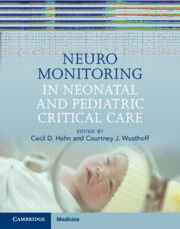Book contents
- Neuromonitoring in Neonatal and Pediatric Critical Care
- Reviews
- Neuromonitoring in Neonatal and Pediatric Critical Care
- Copyright page
- Contents
- Contributors
- Acknowledgements
- Part I General Considerations in Neuromonitoring
- Chapter 1 Overview of Continuous EEG Monitoring in Critically Ill Neonates and Children
- Chapter 2 Technical Aspects of Neurophysiological Monitoring
- Chapter 3 Logistics of Neuromonitoring
- Chapter 4 Nursing Considerations in Neuromonitoring
- Chapter 5 Normal Neurophysiology, Benign Findings, and Artifacts
- Chapter 6 Abnormal EEG in the Intensive Care Unit
- Part II Practice of Neuromonitoring: Neonatal Intensive Care Unit
- Part III Practice of Neuromonitoring: Pediatric Intensive Care Unit
- Part IV Practice of Neuromonitoring: Cardiac Intensive Care Unit
- Part V Cases
- Index
- References
Chapter 3 - Logistics of Neuromonitoring
from Part I - General Considerations in Neuromonitoring
Published online by Cambridge University Press: 08 September 2022
- Neuromonitoring in Neonatal and Pediatric Critical Care
- Reviews
- Neuromonitoring in Neonatal and Pediatric Critical Care
- Copyright page
- Contents
- Contributors
- Acknowledgements
- Part I General Considerations in Neuromonitoring
- Chapter 1 Overview of Continuous EEG Monitoring in Critically Ill Neonates and Children
- Chapter 2 Technical Aspects of Neurophysiological Monitoring
- Chapter 3 Logistics of Neuromonitoring
- Chapter 4 Nursing Considerations in Neuromonitoring
- Chapter 5 Normal Neurophysiology, Benign Findings, and Artifacts
- Chapter 6 Abnormal EEG in the Intensive Care Unit
- Part II Practice of Neuromonitoring: Neonatal Intensive Care Unit
- Part III Practice of Neuromonitoring: Pediatric Intensive Care Unit
- Part IV Practice of Neuromonitoring: Cardiac Intensive Care Unit
- Part V Cases
- Index
- References
Summary
Starting an ICU neuromonitoring program requires in-depth logistical planning prior to initiation. Seemingly small changes to continuous EEG monitoring practices may have a striking impact on resource availability and utilization. Essential decisions include what patient populations are to be monitored and for how long, as well as how often EEG data will be reviewed and by whom. Consideration must be given to which equipment to purchase and the personnel required to handle it. Involving the entire team early in logistical planning -- including EEG readers (attending physicians and trainees), pediatric neurologists, neonatal and pediatric intensivists and nurses, neurodiagnostic technologists, neurodiagnostic laboratory team and hospital administrators -- will help identify possible flaws in the implementation plan and avoid costly financial decisions or committing to practices that resources will not support. Functioning as a multidisciplinary team is essential for the long-term success of an ICU neuromonitoring program. This chapter details practical considerations for establishing and leading an ICU neuromonitoring program.
- Type
- Chapter
- Information
- Neuromonitoring in Neonatal and Pediatric Critical Care , pp. 29 - 34Publisher: Cambridge University PressPrint publication year: 2022

